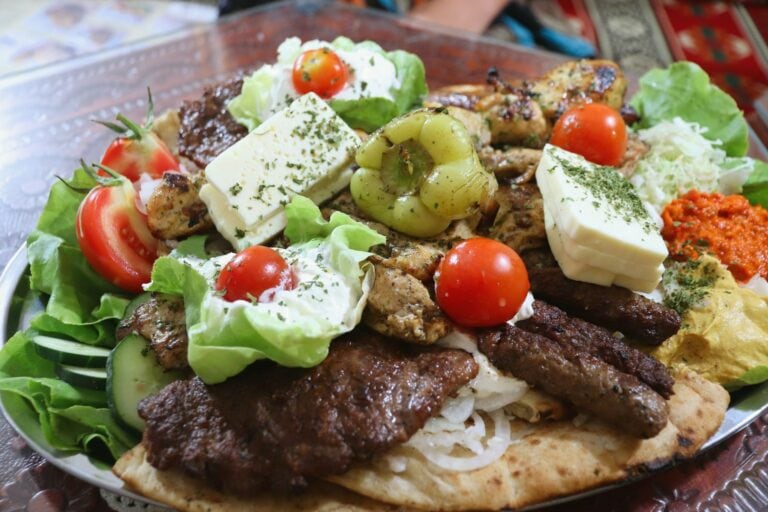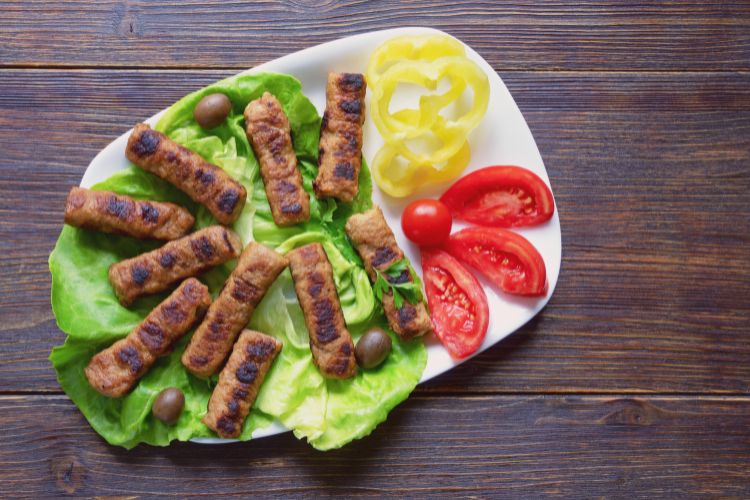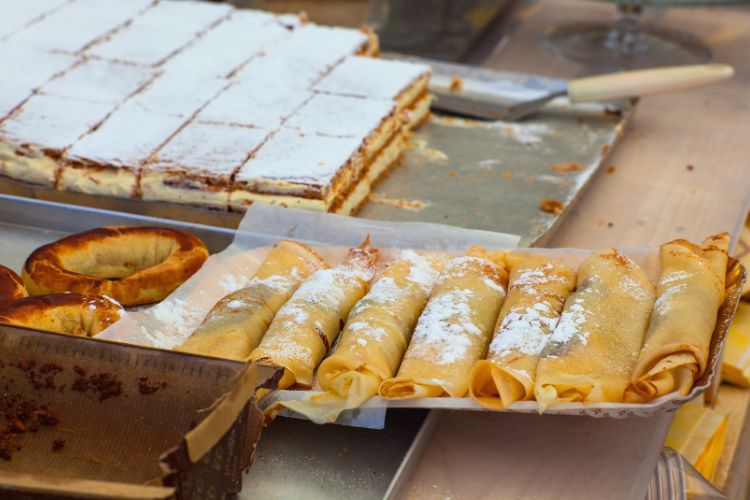
Go World Travel is reader-supported and may earn a commission from purchases made through links in this piece
Varied, filling and delicious—that’s how I would describe our Balkan cuisine. In my country, Croatia, and the entire Balkans, food is not just food; it is a tradition, an experience and a symbol of connection and hospitality.
To be honest, our Balkan food will not be the most photogenic and Instagramable plate of food you’ve ever seen. But it could be the best (and probably the most abundant).
During your visit to the Balkan countries, you will have a chance to try dishes like ćevapi, burek, sarma, pljeskavica, ajvar, baklava and more. You will realize that our cuisine is almost as complex as we Balkans ourselves.
Joking aside, that’s not surprising since Balkan cuisine is influenced by a variety of cultures and civilizations, including the Ottoman Empire, the Mediterranean, the Middle East and Central Europe.

But, Wait a Second: Balkan is…?
Maybe you’re not sure which countries the Balkans include, so here are a few sentences to help. Why? Because some of these European countries, such as Croatia or Montenegro, thanks to their Mediterranean climate and crystal-clear Adriatic Sea, could be your next summer destinations.
The Balkan countries are in southeastern Europe (the Balkan Peninsula). They include Croatia, Montenegro, Slovenia, Albania, Bosnia and Herzegovina, Bulgaria, Kosovo, North Macedonia, Romania and Serbia. They are surrounded by the Adriatic Sea, the Ionian Sea, the Aegean Sea, and the Black Sea.
Essential Balkan Cuisine Everyone Must Try
But enough now; let’s see what smells so good in Balkan cuisine and get those tastebuds excited.
Burek: A Balkan Staple

You didn’t prepare anything for lunch? Buy burek. You want comforting food? Buy burek. Nothing in your life is going well? Buy burek. Here in the Balkans, we love burek.
If you travel to Croatia, Serbia, Bosnia and Herzegovina (especially), or Montenegro, burek is a must. It is not a food you order in a restaurant; you buy it in any bakery (like Mlinar in Zagreb) or buregdžinica (places that sell bureks).
Here in Croatia, we usually buy it as a substitute for a quick meal. It will cost you a few euros per piece and you will be full for hours.
Best Tips & Tools to Plan Your Trip
Anyway, burek is made of thin layers of dough, stuffed with various ingredients. Typically, it is filled with minced meat, while “sirnica” refers to burek with cheese, “zeljanica” with spinach and “krumpiruša” with potato filling.
I have to warn you: if you ask for burek with anything but meat, many people here will quickly inform you that it’s not burek because burek only contains meat.
However, many of us continue to refer to all of these varieties as burek. Of course, at our own risk.
Ćevapi: The Ultimate Comfort Food

On your next trip to Croatia, Bosnia and Herzegovina (especially Sarajevo), Serbia, or Montenegro, you must try the famous ćevapi (or ćevapčići).
Ćevapi are small grilled sausages made from minced meat.
You will find this meat dish in every grill restaurant and in any ćevabdžinica (places that sell ćevapi).
Ćevapi are usually served with ajvar (a roasted bell pepper spread) and kajmak (similar to sour cream). They are well-flavored (not too spicy; just well-flavored), so, if you ask me, the mild taste of the kajmak complements them wonderfully.
The best part, in my opinion, is lepinja. It is a special bread split lengthwise, dipped in a delicious liquid and briefly grilled. It should be juicy, crispy and tender.
Also, when you visit Croatia, Bosnia, Montenegro, or Serbia, you will notice that there is almost no good traditional event without ćevapi.
You don’t need to look for them. Simply follow the delicious smell.
Sarma, Stuffed Peppers & Dolma: A Festive Delight

Everyone looks at me in surprise when I say that I am not a fan of sarma, because everyone here in Croatia likes it. So, during your next visit to Croatia, Bosnia and Herzegovina, Serbia or Montenegro, try sarma.
It is a traditional dish made by wrapping a mixture of ground meat, rice and spices in cabbage leaves. The rolls are then cooked in a delicious broth, allowing the flavors to combine perfectly.
Of course, “lucky me,” sarma is an essential component of almost every traditional celebration here in Croatia. It is offered at holidays, weddings and other important events.
Also, keep in mind that Croats usually don’t order sarma in restaurants; it’s a dish that we make and eat at home. But if you want to try it, you will find it in rustic restaurants with homemade food (in Zagreb, places like Ježeva kućica, Gladni vuk, Točkica, and Ficlek).
If you travel to Turkey, try a similar dish called “dolma,” made by filling vegetables like grape leaves or peppers (in Croatia, that’s stuffed peppers, and I like it more than sarma).
So, when you try sarma, decide whether you agree with me or… everyone else in Balkan countries.
Ajvar: Savory Pepper Blend in Jar

There is no winter in the Balkan region without a jar of mom’s ajvar. Ajvar is a spread made with roasted red peppers (bell peppers), eggplants (sometimes), garlic and olive oil.
You can find it in every store, but the best option is to buy it at the local markets (for example, at the Dolac market in Zagreb).
Also, ajvar could be a great souvenir for your loved ones.
Gyros: Greek Wrap of Happiness

If you decide on a vacation trip to Greece, gyros are a must. They are made of thinly sliced meat (pork, chicken, or lamb) roasted on a vertical rotisserie.
The Greek street food is served in a warm pita with tomatoes, onions, lettuce and Tzatziki sauce (yogurt, cucumbers, and garlic). It is very popular, so you will find it in local Turkish restaurants or street vendors, especially in famous tourist destinations such as Istanbul, Ankara, and Antalya.
Long story short: you can’t go wrong with a gyro.
Goulash: Flavored Comfort in Every Bite

Although goulash is actually a Hungarian meal, it is a popular “guest” dish in several Balkan countries. You will have more than one chance to try it during your visit to Croatia, Serbia, Albania, and Bosnia (or, it’s bograč in Slovenian).
It’s a tasty stew made from tender meat, paprika, onions and peppers. It is not too spicy, but it should be full of delicious flavors because it can be cooked for hours until the flavors blend perfectly. So, goulash will reveal who is a real expert in the kitchen.
You will find it in many restaurants and if you travel to Istria, try it with Pljukanci, an Istrian homemade pasta. That’s one of the best things you can order.
Šopska Salata: Bulgarian and Macedonian Refreshment

In the Balkans, we often eat salads with meals. During your next trip to Bulgaria or Macedonia, try the Šopska Salata.
It is a colorful and refreshing salad consisting of tomatoes, cucumbers, onions, and peppers, topped with feta cheese and olive oil.
Also, it can be a healthy side dish and you will find it in almost every Balkan and Mediterranean restaurant. It will refresh you for the next activities during your trip.
Pljeskavica: The Balkan Burger Phenomenon

Have you heard about Pljeskavica? Pljeskavica is a dish made of ground meats (such as ground beef, lamb, and pork) mixed with onions, garlic, and paprika.
It can be served with flatbread, or lepinja, and toppings such as ajvar and kajmak; often, there will also be onions and French fries.
You can try them in every Serbian grill restaurant, as well as Croatian, Bosnian, Slovenian, and Montenegrin.
You’ll hardly have room after this, but let’s see what’s for dessert in Balkan cuisine.
Palačinke: Croatian Joy in Every Bite

To sweeten your next visit to Croatia, Serbia, Bosnia and Herzegovina, Montenegro, or Slovenia, order Palačinke.
Palačinke are pancakes, but not like American pancakes, they are more like crepes.
It is a very thin dough, filled as desired, but, if you ask me, the best options are basic, such as chocolate spread or apricot jam.
You can find palačinke in various restaurants, but if you are one of those who like to overdo with sweet additions, go to one of the palačinkarnica (places that sell pancakes, like Milky in Zagreb) and create your dream pancake by choosing the ingredients yourself.
Baklava: Golden, Sweet, Nutty Delight

I challenge you: try to eat two slices of baklava. Why? Because it can be very “filling.” Still, your next trip to Croatia, Turkey, or Bosnia and Herzegovina cannot finish without baklava.
Baklava is a Turkish dessert composed of layers of thin pastry, walnuts and honey syrup.
You can eat them in restaurants, but there are also some places that only sell sweets like baklava, such as La Turka in Zagreb. It is traditionally made with a walnut filling, but here you can also try “modern” variants. I tried it with pistachios and chocolate, and I liked them.
One piece will probably seem too small to you, but trust me, one is enough.
Culinary Traditions and Eating Habits in the Balkans
Food as a Cultural Bridge
Not only in architecture, but during your trip to the Balkans, you will see diversity in food too. From Eastern Europe, Balkan cuisine embraces hearty stews and pickled vegetables.
The Ottoman Empire’s legacy is visible in foods such as kebabs and baklava, while Mediterranean influences include the use of olive oil, tomato sauce, and herbs.
But… how spicy is it?
Is Balkan Cuisine Spicy?
There is a common misconception that Balkan cuisine is quite spicy. But no worries; Balkan cuisine is more focused on aromatic flavors than intense spiciness.
So, no, you won’t be hungry during your trip to the Balkan countries because everything is too spicy.
Daily Dining Rituals in the Balkans

I don’t know if you will experience culture shock because of this, but we eat almost anything with bread. Apart from things like soup, pasta or pizza.
So, during your next visit to Croatia, start your day with breakfast and things like fresh bread, cheese or cottage cheese, cured meats and, of course, strong Turkish coffee.
Lunch is the main meal; it is a time when families sit together and share traditional dishes served with salads and bread.
You can have a few sips of rakija as an aperitif. Why just a few sips? You will understand once you try.
In the afternoon, enjoy a cup of Turkish-style coffee with treats such as pita or baklava (phyllo bread with walnut layers).
Dinner is usually lighter, with mezze-style meals.
Keep in mind that food is more than just food here in the Balkan countries; it is a symbol of connection and tradition, celebrating togetherness around the table.
And that is what I love about my country: anything could happen, yet at the end of the day, family will gather around the table to eat together. And that’s pretty much what life is all about, right?

